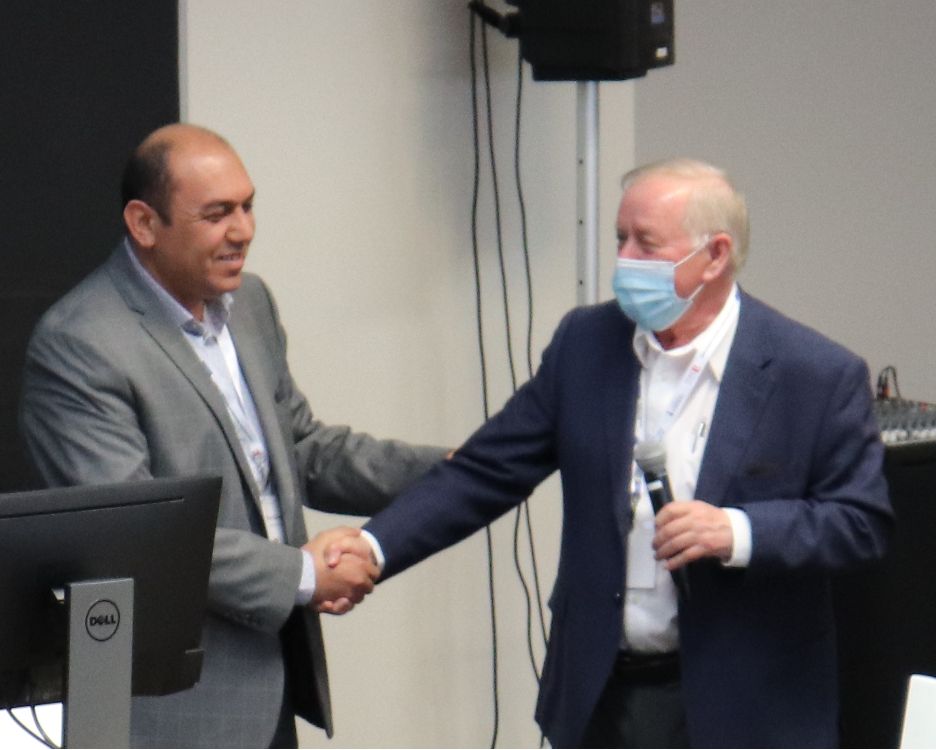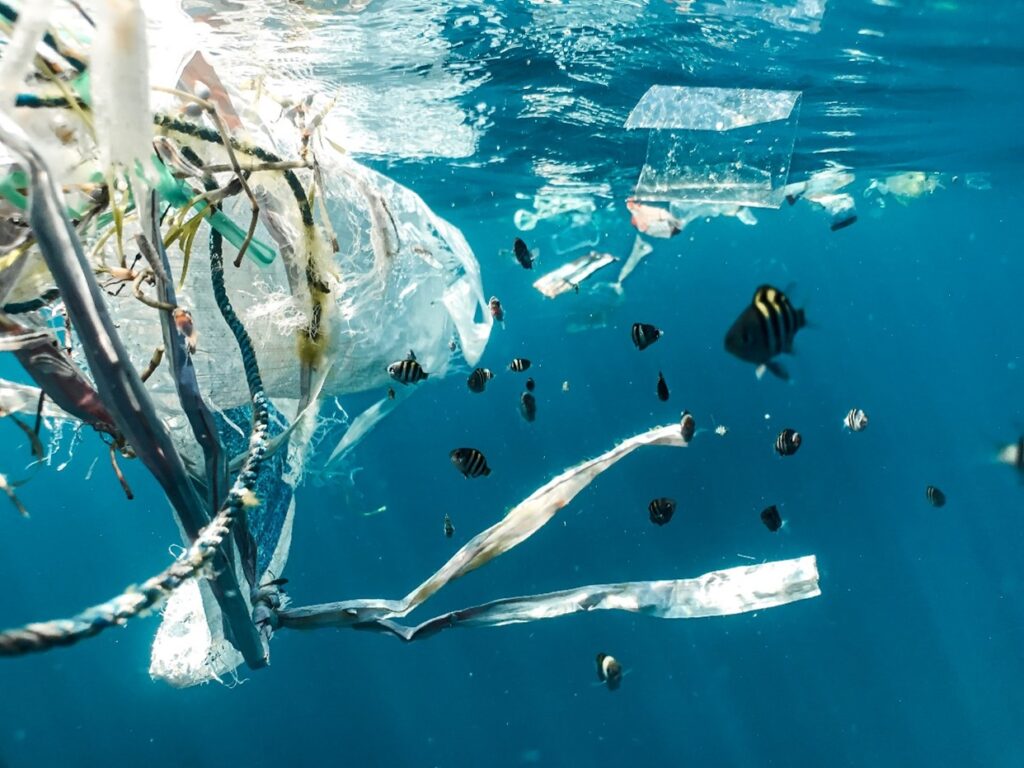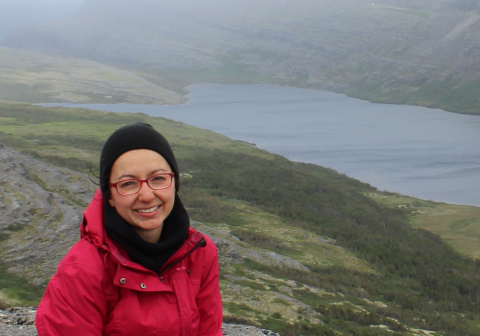Association canadienne sur la
qualité de l'eau
MAY 2022
NEWSLETTER
Spring has sprung and we are bringing you another newsletter from the Canadian Association on Water Quality!
Written by researchers and experts from Canadian institutions, we aim to provide informative and easily digestible content on Canadian water quality research! Feel free to share these short articles with your network – creating a community that is water-informed!
This April 2022 issue features short articles from researchers in our Western and Eastern regions, and an interview with our Central Regional Director, Dr. Stéphanie Guilherme. Newsletter content will be archived on the CAWQ Website, so feel free to check us out on cawq.ca!
We look forward to continually engage our community and create content on water quality research. |
|
A message from CAWQ President, Dr. Elsayed Elbishbishy

Last month during the 57th Central Canadian Symposium on Water Quality Research, I had the great honour of taking on the role of President of Canadian Association on Water Quality (CAWQ ACQE) for the coming two years. Thank you very much for our Past President, Michael Lywood for the great leadership that he is always providing to the water professionals. I look forward to working alongside with the board members and all the water professionals to serve the association and provide great opportunities to the Canadian Water Professionals. If you are a water professional and you are interested in making positive change, then join us at the CAWQ. I’m always available for discussing any new ideas/initiatives that can help the Canadian Water Professionals. Stay tuned for the coming events and activities!
|
|
Tailing Management Framework for Albertan Oil Sands Industries
Deborah C. Crominski da Silva Medeiros, PhD Student, University of Alberta
The Tailing Management Framework (TMF) for the Mineable Athabasca Oil Sands is the name given to the guidelines developed by the Government of Alberta regarding managing new and existing fluid tailings, treatment, and reclamation, in which increasing the rate of reclamation and decreasing the number of tailings ponds are the key objectives. Therefore, according to the Government of Alberta, the land must be ready to reclaim after 10 years of the ‘end of mine life’ of a project. Based on key principles of the TMF, oil sands producers around Alberta have been applying certain strategies to cope with the requirements. According to Canada’s Oil & Natural Gas Producers, the first tailings pond as reclamation of the oil sand mining industry was the Suncor’s Pond One, completed in 2010. Since then, Suncor has promoted tailings management through the holistic approach of Tailings Reduction Operations (TROTM) in association with the Permanent Aquatic Storage Structure (PASS) technology, in which fast dewatering of fluid tailings is achieved by adding a flocculant to trap clay particles. Syncrude implemented a centrifugation technology combining tailings with gypsum and flocculant to promote the dewatering process, in which clay material resulting from centrifugation is applied to the development of landscapes, and the released water is recycled into plant operations. On the other hand, Imperial Oil is developing a non-aqueous extraction process to reduce the water consumption in the source by 90%, which could significantly decrease the footprint of fluid tailings ponds, leading to faster land reclamation.
Overall, the TMF guidelines were created to ensure environmental protection and environmentally sustainable oil sands operation in Alberta. The mining industries in Alberta have been exploring several technologies to meet the regulations and also funding research in universities across Canada, including two major research universities in Alberta (University of Alberta and University of Calgary), to move even further in the path to minimize the environmental risks of tailings. |
|
|
Dealing with aging water distribution systems
Wafa Dastyar, MSc, University of Alberta; Currently PhD Student, University of Miami
Canada possesses 7% of the world’s freshwater supply with only 0.5% of the world’s population, which is intensively urbanized (82% of people live in cities with ≥ 20,000 people) while having abundant small/remote and Indigenous communities. However, in recent decades, Canadian freshwater availability and safe drinking water have been under considerable strain owing to climate change, contamination, and aging infrastructure. For instance, 28% of the water mains in North America are nearing end-of-service life with over 50 years old.
Alberta is not an exemption from the facts mentioned above, with ~10-25% water loss through the distribution system. Over the last six years, the old infrastructure has led to a 27% increase in pipe breaks, thereby wasting water, losing revenue, and contaminating water throughout Canada. Specifically, in Edmonton, EPCOR had targeted reaching 93.7% of main breaks repaired back in service within 24 hours by installing or repairing boss clamps, repairing lead joints, replacing pipe sections, and repairing steel transmission main. It should be cited that responding to the main break along Alberta may have some similarities, but they are not perusing the same procedure. Various practices have been implemented in Edmonton and Calgary, including standard operating procedures such as ‘super-chlorinating’ to prevent microbial contamination during water utility main breaks. However, In Edmonton, repaired main is put back into normal operation after testing with field kits for residual chlorine and turbidity pass. In Calgary, the main remains controlled until secondary flush and biological samples are analyzed, and results pass. Without a doubt, a holistic roadmap provides appropriate databases on potential pipe breaks and potential threats that are not available yet for Alberta. We aim to have an interview with corresponding authorities or EPCOR as one of the main utility companies in the Edmonton greater region offering both water and wastewater to figure out recent progress and other roadblocks, challenges, and potential solutions. |
|
|
Microplastics and crude oil form agglomerates in aquatic environments
Min Yang, PhD Student, Memorial University of Newfoundland
Microplastics are widespread in aquatic environments and pose a potential threat to aquatic organisms. Studies reported the co-contamination of microplastics and other pollutants and their bioaccumulation through food chains in aquatic environments. Oil pollution, which comes from natural seeps and accidental oil spills, has become a major concern for the water environment, leading to toxic effects on the aquatic ecosystem.
Many studies have explored the source, distribution, transport, and fate of microplastics and oil pollution as individual topics, but their interactions have rarely been explored. As microplastics were detected in areas in oceans affected by oil spills, researchers started investigating if and how microplastics could interact with crude oil in 2020. They found that microplastics and oil could form microplastic-oil agglomerates. These agglomerates existed in different seawater layers from the seawater surface to the bottom. Moreover, the agglomerate formation would reduce the efficiency of oil spill clean-up methods such as oil treating agent – chemical dispersant application. The physicochemical properties and toxicity of microplastic-oil agglomerates may be very different from microplastics or oil. Understanding these aspects may help us better evaluate their environmental co-impacts.

Photo by: Naja Bertolt Jensen
Oil spills and plastic pollution are both potential concerns in the North Atlantic Ocean. Studies on microplastic-oil agglomerates could provide fundamental insights on the impact of microplastics on oil spill clean-up. Exploring microplastics and oil interaction can better inform decision-making in response to oil spills in the North Atlantic region. |
|
|
|
CAWQ Executive Committee Highlight
|
|
Dr. Stéphanie Guilherme
CAWQ Central Regional Director
Assistant Professor, Civil Engineering, University of Ottawa

Pathways in Water Quality
Written by Gabriela Jiménez, MASc Student, Carleton University
Dr. Stéphanie Guilherme is an Assistant Professor at the University of Ottawa since 2020 and a member of the CAWQ Board of Directors since 2021. She is originally from France and moved to Canada after completing her Master’s in Environment, Toxicology and Health. While her studies focused more on analytical chemistry, after completing an internship at Veolia on drinking water, she became passionate about the work in this field. What she enjoys the most is that research on water could involve many disciplines and require collaborative approach.
“The study of water includes so many different aspects, it requires a wide range expertise and goes on different directions, so I am really attracted by that”
After her Master studies, she decided to pursue a PhD at the Université Laval because of a research opportunity to study drinking water quality in small systems in Newfoundland and Quebec. Not only did she study 25 small water systems, but she also involved water operators and community members in her research team, where she recognized the value of collaboration in working in isolated areas. This collaboration can empower communities and result in direct positive impacts from the research. From that encouraging experience, she chose to continue working in collaborative research, first completing several post-doctorates in British Columbia, and later working with northern Indigenous communities in Northern Québec, Nunavik, on drinking water quality.
Today, Dr. Guilherme teaches Civil and Environmental Engineering courses and develops her own research with northern communities, and she is actively involved in the Centre for Indigenous Community Infrastructure at the University of Ottawa – a hub that aims to foster knowledge exchange to provide sustainable solutions for challenges faced by Indigenous communities. “As there is no distribution system in northern communities, there is a need to better understand the impacts of their truck and storage systems on their drinking water quality, so there is a lot of research to get done”, highlights Professor Guilherme. Furthermore, she created a research committee gathering different stakeholders involved in water supply in Nunavik, with the purpose of promoting knowledge exchange between different stakeholders and resources such as communities, Municipal Works departments, public health departments, and Natural Resources departments. This committee also aims to ensure that water and wastewater research meets needs and expectations of the Nunavik population, by ensuring a continuous follow-up of the projects with involved stakeholders.
The largest project that Dr. Guilherme is currently working on is a study on appropriate water processes for safe water storage that aligns with community needs and preferences. For example, communities prefer lower levels of chlorine in drinking water; thus, this research aims to find the optimum operation parameters to assure minimum concentration of chlorine in the tanks for safe water quality while considering users’ preference. Therefore, to complete water quality tests, questionnaires to better understand the population perceptions and preferences regarding water consumption are taken into account in order to develop strategies that meet their needs.
No doubt that inclusive and collaborative research is the common factor in Dr. Guilherme’s work, and that is what she aims to bring to CAWQ, “I hope my team and I can contribute with our expertise on ‘how to do inclusive research in Indigenous communities’ and all the aspects on improving drinking water quality in the North”. She would like to continue to collaborate with professionals with different backgrounds on pan-Canadian research on drinking water quality with Indigenous communities. “At the Centre for Indigenous Community Infrastructure, we are continuously developing multidisciplinary projects, and we are always open for new collaborations”. If any researcher or student is interested, do not hesitate to contact Professor Guilherme directly. |
|
|
|
|
|